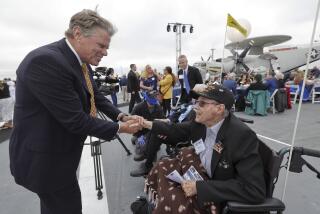50 Years After Battle, Midway Island on Standby : Military: Fierce fighting was turning point of World War II. A dwindling U.S. military presence makes the atoll’s fate uncertain.
- Share via
It was six months almost to the day after the bombing of Pearl Harbor. Midway Island, a dot in the Pacific, was the enemy’s target.
At 4 a.m. on June 4, 1942, U.S. Navy Ens. Albert K. Earnest was in the cockpit of his torpedo bomber on a Midway runway, warming up his engine and waiting for search-plane sightings of Japanese aircraft carriers.
Midway’s two tiny islands, U.S. territory about 1,300 miles northwest of Pearl, would be heavily attacked. Their fuel storage tanks would be hit. Remarkably, the three runways would not.
By 8:30 a.m., Earnest’s plane was the only one of the six torpedo bombers to make it back to Midway. “We had a very bad day,” he recalls at age 75.
But about two hours later, in six devastating minutes 50 years ago, U.S. dive bombers and fighters delivered a blow from which the Japanese would not recover.
“Midway was the turning point of the war in the Pacific,” said historian William S. Dudley of the Naval Historical Center in Washington.
Ens. George H. Gay, who flew his Devastator torpedo bomber off the Hornet just after 8 that morning and crash-landed it into the ocean just after 9, had a fish-eye view of carrier-launched air superiority in naval warfare.
“It’s not easy to dig a foxhole in the ocean,” he recalls. “I survived because I found a black piece of debris, deck padding from my plane. I put it over my head and hid under it.”
Gay spent 30 hours in the sea. “I was at the bull’s-eye. I saw the Soryu, Kaga and Akagi sink,” he said. “I could feel the concussions as the bulkheads went.”
Later, the last Japanese carrier, Hiryu, was destroyed. The Americans lost only the carrier Yorktown.
Rescued by a Navy seaplane, Gay was the only member of Torpedo Squadron 8 to survive.
“I lost 29 friends,” he said. As Midway’s most famous survivor, Gay, 75 and a retired TWA pilot, says he hopes the emphasis of the 50th Midway commemorative events June 4-7 will be on those who didn’t make it.
The Midway Islands gave their name to the battle, which gave its name to the aircraft carrier Midway, commissioned in 1945, and to Chicago’s Midway Airport, renamed in 1949 when it was the world’s busiest.
During the war, several thousand servicemen were stationed on Midway Island. Today it has only eight Navy men. They oversee 200 employees of a private contractor who keeps the naval air facility--Midway’s sole installation--operating. Most of these civilians are Sri Lankans, Thais and Filipinos.
Midway is on standby status, the Navy says. Military planes are no longer based there; its only ships are tugboats.
“We’re a medevac. Three or four times a month, we rescue a fisherman, typically Japanese, Taiwanese or Korean, who has been hurt in a fall,” said Lt. James Van de Voorde.
Van de Voorde, 33, has been on Midway since last September. The usual tour of duty is one year. “The toughest part,” he said, “is being away from my wife and four children” in Oak Harbor, Wash.
“Thursday is everybody’s big day here,” he said. That’s when the once-a-week plane arrives from Honolulu bringing food, supplies and mail.
At the western end of the Hawaiian archipelago, Midway is the only island that was not made part of the state of Hawaii in 1959. Formally annexed in 1867, the coral atoll remains unincorporated U.S. territory under the Navy.
Named because it lies about midway between North America and Asia, Midway also sits halfway around the globe from the prime meridian at Greenwich, England.
In 1935, Pan Am made aviation history when its China Clipper refueled on Midway on a pioneering flight across the Pacific. Pan Am put the island on the map until the jet age bypassed it.
Today the Navy shares Midway with its longtime inhabitants: several hundred thousand albatrosses--noisy, ungainly creatures that American sailors dubbed “gooney birds.”
“They’re everywhere--outside your door, on the golf course, on the runway,” said Van de Voorde. Crews have to clear the runway of the gawky gooneys, which have a seven-foot wingspread, before planes can land or take off.
Midway may soon be left to the birds. A dwindling military presence makes the fate of the naval facility uncertain. Already the Midway, “born in war, decommissioned in peace” April 11, has been mothballed.
“The very name Midway,” Chaplain Paul Murphey said at the decommissioning, “has meant the decisive turning point from defeat to victory, from despair to hope.”
More to Read
Sign up for Essential California
The most important California stories and recommendations in your inbox every morning.
You may occasionally receive promotional content from the Los Angeles Times.













